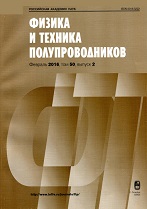|
|
Физика и техника полупроводников, 2020, том 54, выпуск 3, страница 244
(Mi phts6637)
|
 |
|
 |
Полупроводниковые структуры, низкоразмерные системы, квантовые явления
Characteristics of DC electrical conductivity and optoelectronic features of tin dioxide nanocrystals synthesized by Sol-Gel chemistry
A. M. Badrab, H. H. Afifyc, Sh. E. Shakerab, H. A. Elshaikhab
a Department of Physics, Faculty of Science, Aswan University,
Aswan, Egypt
b Research Center for NanoMaterial Studies and Their Promising Technologies, Aswan, Egypt
c Department of Physics, National Research Center, Cairo, Egypt
Аннотация:
Nanostructured tin dioxide powders were synthesized successfully through a Sol-Gel route. Subsequent thermal treatment was carried out at different temperatures to obtain the SnO$_2$ powders in crystal form. The identification and evolution of the crystal structure were determined by analyzing the results of the $X$-ray diffraction (XRD) for the powder products. Based on these results, the influences of the post-annealing temperatures on both the crystallinity and the crystallite size were investigated and analyzed. The diffuse reflectance spectra were measured for insight into the optical band gap and optical transition in the resulting powders. The results of the diffuse reflectance spectroscopy (DRS) revealed that all the obtained nanocrystalline powders exhibit direct allowed transitions. The change in the width of the optical band gap was discussed and analyzed in lines with the variation in the post-annealing temperature. The resulting SnO$_2$ powders were compressed into dense pellets for the electrical measurements. These measurements were carried out in an evacuated medium at different working temperatures ranging from 77 to 300 K. The effects of the working and the post-annealing temperatures on the DC electrical conductivity were discussed and analyzed exhaustively for all the pellet samples.
Ключевые слова:
SnO$_2$ nanostructures, structural properties by XRD, optical spectroscopic analysis by DRS, electrical transport properties.
Поступила в редакцию: 23.03.2019
Исправленный вариант: 15.07.2019
Принята в печать: 16.09.2019
Образец цитирования:
A. M. Badr, H. H. Afify, Sh. E. Shaker, H. A. Elshaikh, “Characteristics of DC electrical conductivity and optoelectronic features of tin dioxide nanocrystals synthesized by Sol-Gel chemistry”, Физика и техника полупроводников, 54:3 (2020), 244; Semiconductors, 54:3 (2020), 297–310
Образцы ссылок на эту страницу:
https://www.mathnet.ru/rus/phts6637 https://www.mathnet.ru/rus/phts/v54/i3/p244
|


| Статистика просмотров: |
| Страница аннотации: | 48 | | PDF полного текста: | 9 |
|





 Обратная связь:
Обратная связь: Пользовательское соглашение
Пользовательское соглашение
 Регистрация посетителей портала
Регистрация посетителей портала Логотипы
Логотипы








 Цитирование в формате
Цитирование в формате 